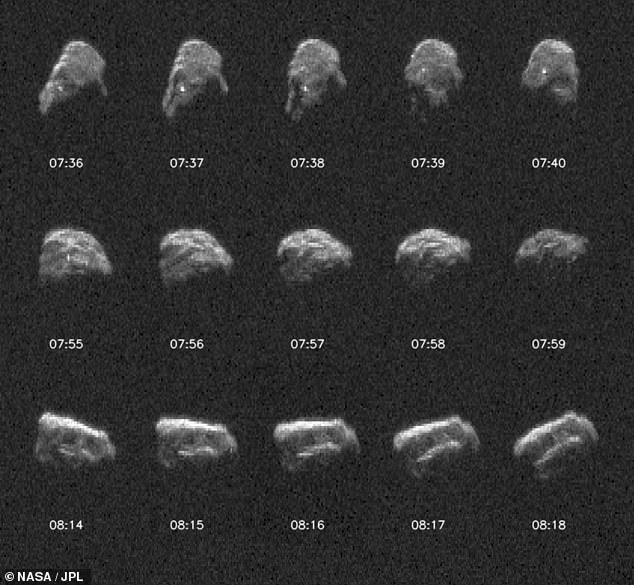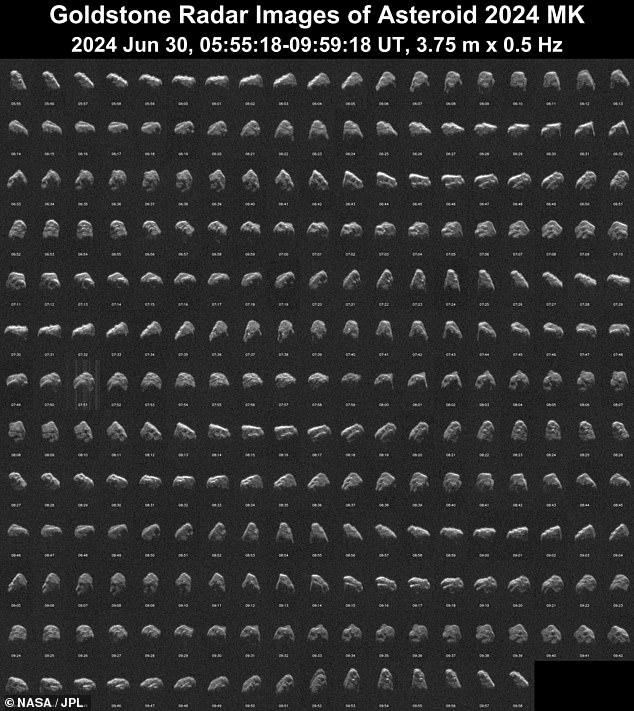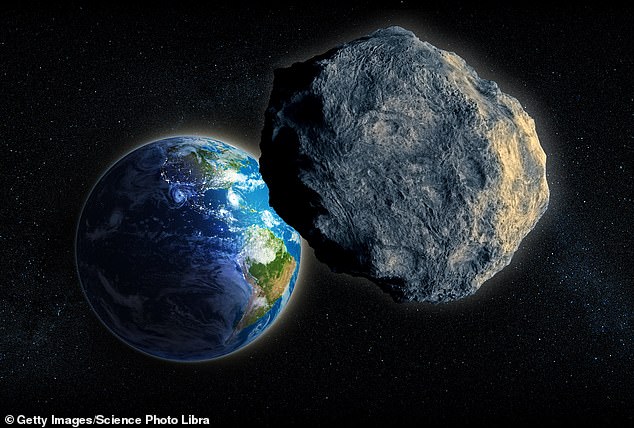NASA Captures Moment ‘Planet-Destroying’ Asteroids Whizz By Earth
NASA captured two “planet-destroying” asteroids on video last week, one recently discovered and the other dragging its own moon along with it.
Scientists from the US space agency Jet Propulsion Laboratory (JPL) in South California tracked and filmed the two giant space rocks with the 70-meter-wide Goldstone Solar System Radar, which also measured the objects’ sizes.
Asteroid 2024 MK was first spotted just 13 days before its closest approach to Earth. According to NASA radar, it was a 152-meter-long, “elongated and angular” object. The asteroid struck our planet on Saturday.
And asteroid 2011 UL21, an object nearly a mile wide that hurtled past Earth on Thursday at 58,000 miles per hour (93,000 kilometers per hour), was spotted with a “moon” orbiting about 2 miles (3 kilometers) from its surface.
Asteroid 2011 UL21 (top row), an object nearly a mile wide hurtling past Earth at 58,000 miles per hour, was imaged by NASA with a “moonlet” (bottom row) orbiting Earth within 2 miles of its surface
The European Space Agency, which partners with NASA in planetary defense, was vocal about the late identification of asteroid 2024 MK.
“An asteroid of this size would cause significant damage,” ESA officials said.
“Its discovery just before it flies past our planet underscores the continued need to improve our capabilities to detect and monitor potentially hazardous near-Earth objects (NEOs),” the agency said.
The orbit of asteroid 2024 MK was first recorded on June 16 by the NASA-funded Asteroid Terrestrial-impact Last Alert System (ATLAS) in South Africa. The asteroid has since been altered by the incredibly close collision with Earth’s gravity.
The object zoomed in on the distance between Earth and the moon’s orbit, coming within about 296,000 kilometers of the surface of our planet’s atmosphere.
While NASA classified 2024 MK as a “potentially hazardous asteroid,” NASA JPL reported that “calculations of its future motion indicate that the asteroid poses no threat to our planet in the foreseeable future.”
Dr. Lance Benner, a planetary scientist at JPL who helped track the two deadly asteroids, said such a “near collision” isn’t expected to happen again for decades and that the U.S. space agency has been working hard to make the most of it.

Asteroid 2024 MK (pictured) was first spotted just 13 days before it made its closest approach to Earth. NASA radar determined the space rock to be a 500-foot-long, “elongated and angular” object

The European Space Agency (ESA), which works with NASA on planetary defense, was not mincing words about the late identification of asteroid 2024 MK (radar images above). “An asteroid of this size would cause significant damage,” ESA officials said.
“This was an extraordinary opportunity to investigate the physics of a close-to-Earth asteroid and obtain detailed images,” said Dr. Benner.
2011 UL21, which orbits our sun approximately every 1,130 days, recently passed planet Earth at its closest point in more than a century.
NASA JPL was able to determine that this nearly three-kilometer-wide planet killer was “roughly spherical” thanks to the near-collision on June 27.
The very close and rapid passage of UL21 in 2011 also helped the Goldstone radar, also known as Deep Space Station 14 (DSS-14), discover the ‘moon’ asteroid orbiting the space station.
“About two-thirds of asteroids of this size are thought to be binary star systems,” Dr. Benner noted of the find.

Two ‘planet-destroying’ asteroids – one discovered just two weeks ago and another dragging its own moon along – were captured on video by NASA as they hurtled past Earth
“Their discovery is particularly important because we can use measurements of their relative positions to estimate their orbits, masses and densities. That information gives us important clues about how they might have formed,” he continued.
Like 2024 MK, NASA JPL reported that 2011 UL21 and the moonlet that makes it a “binary system” are “potentially hazardous.”
2011 UL21 is actually categorized as a ‘planet killer’, according to Living sciencewhich is defined as an asteroid capable of causing continental-scale damage and blasting out enough debris upon impact to cause significant climate changes.
“Calculations of the satellite’s future orbits show that it will not pose a threat to our planet in the near future,” they noted.
Scientists at the Massachusetts Institute of Technology announced in 2023 that an asteroid in that category would not hit Earth for at least 1,000 years.
